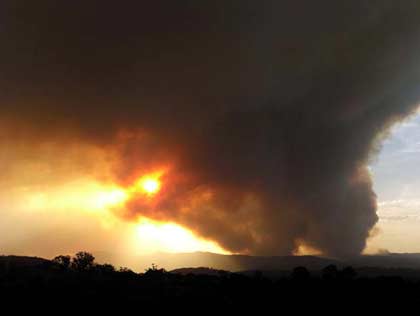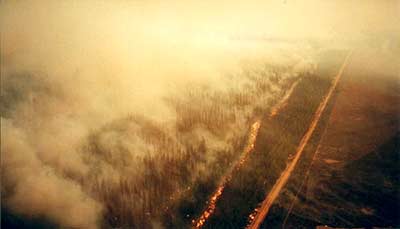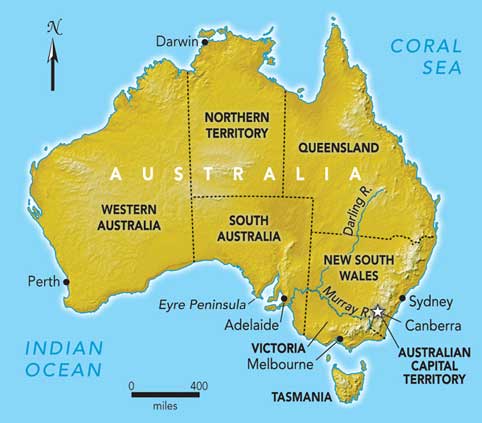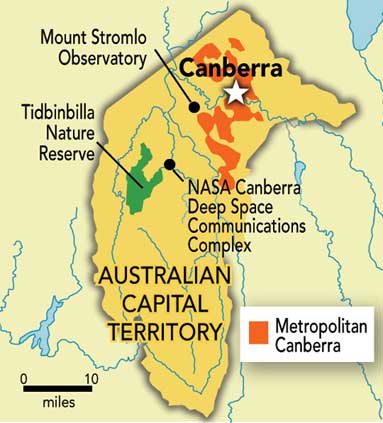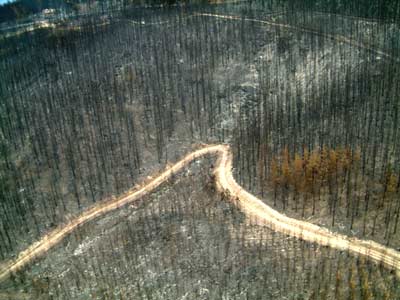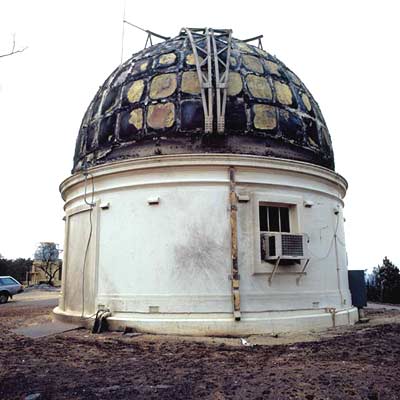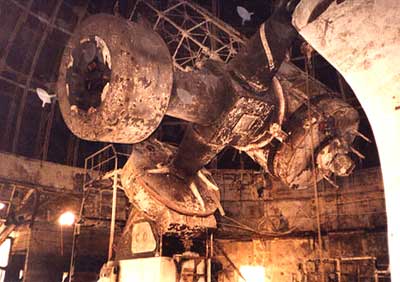Fire Down Under

Bushfire season pays Australia a hellish visit each year.
Drought and climate change could be making the infernos worse.

By Dan Drollette
| ||
By midday on January 18, 2003, a hot, summer Saturday in Canberra, Australia’s capital city, smoke from the largest wildfires in the history of the surrounding Australian Capital Territory had eclipsed the Sun. Firefighters were battling flames along a twenty-two-mile front.
Few people were overly concerned. Summer is fire season in bush country, and Canberra, on the southeastern fringe of Australia’s outback, is often called the bush capital. Wildfires there are as much a part of a down under summer as barbecues on the beach at Christmas. Although low-intensity fires fed by grass and scrub had been steadily advancing on the city’s sprawling outer suburbs, they seemed to pose little danger to life, limb, or property.
But a two-year drought had primed the Australian Capital Territory for something bigger. At about 1:30 in the afternoon, wind-fanned flames leapt to the tops of the native eucalypts and imported pines, igniting them.
What came next is best described by the professional terminology of fire meteorologists: a “blowup.” Modest ground fires became high-intensity blazes with temperatures exceeding 1,800 degrees Fahrenheit—hot enough to melt copper. Eyewitnesses described plasmalike balls of fire detaching from the fire front and blowing forward to ignite everything in their paths. Flames towered a hundred feet above the trees, and the wildfire grew so hot that it generated 150-mile-an-hour winds. Cars and trailers were blown around. Three-foot-wide trees were uprooted and hurled atop houses, and full-grown pines were snapped in half.
Fire crews had no time to evacuate. The firefighters huddled beneath their vehicles while fire-induced winds blew in windshields and tore off doors. Fire commander John Ryan of the New South Wales Rural Fires Service later told the Advertiser in Adelaide, “There were birds falling out of the sky as we were overrun by the firestorm.” Some firefighters reported that wild animals that had caught fire also hid beneath the trucks. Describing the scene later, Peter Roth, Ryan’s deputy, told reporters, “It was more like a fire hurricane than a firestorm.” The deputy added, “I said to the chief, ‘If we don’t see you again, it’s been nice knowing you.’”
Roth and Ryan survived, but others were not so lucky. The fires ultimately killed four, destroyed more than 500 homes, and reduced nearly two-thirds of the Australian Capital Territory to ash. The losses included the Australian National University’s giant optical telescopes at the Mount Stromlo Observatory, just west of Canberra. They were completely destroyed, their metal domes and telescope mountings melted.
The fires could be as capricious as tornadoes. Farther outside town, flames stopped just yards from the radio dishes of NASA’s Canberra Deep Space Communications Complex, vital for maintaining contact with dozens of spacecraft, including the Mars rovers Spirit and Opportunity.
|
The fires of 2003—and the ones that struck the Eyre Peninsula of South Australia this past January, killing nine people and incinerating some 200,000 acres—were not totally unexpected. After all, much of Australia is hot and dry, and the continent has been that way for a long time.
But Australia might be getting even hotter and drier and, by all historical comparisons, the intensity of the recent fires is epic. A deep drought has continued for the past decade. Reservoirs serving the city of Canberra and nearby areas have been storing as little as 35 percent of capacity. Canberra has recovered steadily since the fire of 2003, but every Australian knows the risk of fire each summer remains high. A number of climate experts have begun to ask whether the current drought and the recent fire seasons, which have been considered exceptional, are actually the new commonplace.
To answer that question, a number of familiar global phenomena must be taken into account. The weather system known as El Niño, for instance, has had major effects on Australia’s climate for millennia. The effects of global warming, atmospheric pollution, and water shortages—for which humanity may bear a substantial responsibility—must also be factored in. And even if climatologists can sort out the causes of Australia’s suffering, is there anything humanity can do to reverse their effects? The answers are not necessarily encouraging.
The conditions in Australia today seem unlike anything on record. Early written accounts, archaeological data, tree rings, cores of ocean sediments, and other indicators are all beginning to paint a picture of the history and prehistory of Australia’s climate. According to David A. Jones, a climatologist at the Bureau of Meteorology in Melbourne, Australia’s climate is rapidly warming, and the warming trend is compounding the drought. Another climatologist, Timothy P. Barnett of the Scripps Institution of Oceanography in San Diego, agrees. He points out that the center of Australia—what Aussies call the “dead heart”—appears to be getting hotter and drier more quickly than the edges of the continent. Such preferential heating, he says, is evidence of a prolonged, permanent climate shift.
|
Droughts are becoming distressingly common across many of the world’s less-watered regions. Although droughts can develop anywhere, areas dry to begin with seem most likely to be hit. At a recent meeting of the American Meteorological Society, Aiguo Dai of the National Center for Atmospheric Research in Boulder, Colorado, announced that the percentage of the Earth’s land area undergoing “serious drought” has doubled in the past thirty years. Climate experts at the U.S. National Oceanic and Atmospheric Administration envision such prolonged, severe, geographically wide-ranging events in the future that they have coined the term “megadrought” to describe them.
From his studies of historical climate patterns recorded in tree rings, Thomas W. Swetnam of the University of Arizona in Tucson (a former firefighter with the U.S. Forest Service) sees a clear link between the worst droughts and the worst fire years. And there are good reasons to think that El Niño, a big factor in Australia’s droughts, is becoming more powerful.
|
For three or four years out of five, on average, ocean temperatures stray very little from their mean. But in that fifth year—the interval itself is a rough one—the sea surface and atmosphere in the tropical regions of the western Pacific Ocean warm dramatically. The warm water and air masses move eastward across the equatorial region, until they reach the west coast of the Americas. Because it arrives around Christmas, the warm currents and air masses are known as El Niño, literally “the (Christ) child.” El Niños usually last between one and two years, and cause wet conditions off Peru and in the U.S. Southwest. In Australia, however, an El Niño causes drought, as high-pressure cells, or air masses, develop over the northern part of the Australian continent and create persistent warm and dry conditions there.
After an interval of three to seven years, an opposite phenomenon, dubbed La Niña, “the girl,” takes hold, which lasts a similar length of time to El Niño. In La Niña years Australia becomes wetter.
The cycling between the two extremes encourages the evolution of fire-dominated ecosystems. In wet years, grasses, trees, and other vegetation grow abundantly, producing large amounts of fuel to burn during dry periods. The ashes from the fires serve as fertilizer for a new round of explosive growth during the next wet phase.
The exact mechanism driving an El Niño year is complex and still being worked out, and the cycles are not entirely predictable. But in the late 1980s Neville Nicholls, a climatologist at Australia’s Bureau of Meteorology, pointed out that the pressure difference between highs over Darwin, the capital of the Northern Territory, and lows over the island of Tahiti has been a good historical indicator of whether an El Niño was either under way or about to begin. That difference, Nicholls suggested—now known as the Southern Oscillation Index (SOI)—could serve to forecast future Australian droughts; the more negative the index, the better the chances for a drought. The index has become so widely accepted that it is misused for short-term forecasting: the latest SOI is now a part of every weather report on the Australian evening news.
Climatologists are still seeking the answers to two million-dollar questions. First, what drives the frequency of the switches from hot, dry El Niño years to moist La Niña ones over the centuries? And second, what causes the varying intensities of the events? Longer cycles, in which one or the other extreme predominates, apparently exist; explaining those would go a long way to predicting whether, say, one wet year after a five-year drought signals only temporary relief or marks the beginning of multiyear wet period.
There is, of course, a third question. Why are the extremes becoming more extreme? Why are the wet phases getting wetter, and the warmer phases getting drier and more beset by fire? Global warming seems a prime suspect. “Among scientists, there’s no real question about whether global warming exists or not,” says Barnett. “The only questions are more a matter of how much and how fast, and what its specific impacts are in a given area.”
“The debate about global warming is over,” he adds, “at least among rational people.”
According to the Intergovernmental Panel on Climate Change, the past decade included five of the hottest years since accurate meteorological records began to be kept in the nineteenth century. That fact is just one piece of the evidence that global warming is caused, at least in part, by human activities.
The story by now is a familiar one, but it is no less urgent for that. When certain gases—carbon dioxide, water vapor, methane, chlorofluorocarbons, and others—are released into the atmosphere, they naturally act like the glass panes of a greenhouse. Visible light can pass through them, but radiant heat from the Earth’s surface cannot so readily flow back through the gases and into space.
|
The heat-retaining actions of greenhouse gases already in the atmosphere have been enhanced by a 30 percent increase in atmospheric carbon dioxide since the Industrial Revolution began. Carbon dioxide levels are now higher than they have been at any other time in the past 420,000 years. The resultant warming is thought to be a factor in the further desiccation of areas that are already dry.
Australia’s normal climate variability makes it hard to pinpoint the effects of global warming—not that they are easy to sort out even in far less complicated systems. Global warming, despite its name, is not just a uniform rise in global temperature. The retained heat can lead to quite paradoxical outcomes. Some global-warming models, for instance, predict a massive cooling in northern Europe, as changes in the salinity of Atlantic seawater, resulting from the melting of polar ice, shut down the Gulf Stream.
An additional, complicating factor in the case of Australia is the effect of aerosols—fine droplets of water, or particles of dust, soot, pollen, and the like, which can remain suspended in the atmosphere for weeks at a time or longer. Beate G. Liepert, a climatologist at Columbia University’s Lamont-Doherty Earth Observatory in Palisades, New York, studied the effects of atmospheric aerosols in combination with global warming. With a computer model developed by Johann Feichter and Erich Roeckner at the Max Planck Institute for Meteorology in Hamburg, Germany, and Ulrike Lohmann of the Swiss Federal Institute of Technology in Zurich, Liepert found that atmospheric aerosols make Australia drier. Aerosols, like greenhouse gases, contribute to global warming. The warmer the atmosphere, the more water it can hold. And in general, if water is locked up in the atmosphere, global rainfall is reduced, including the rainfall over Australia. So as El Niño brings dry times, aerosols make the climate even drier.
Intriguingly, Liepert discovered that the effects of aerosols, like those of global warming, are uneven: they do not weaken India’s monsoon system, for instance. In fact, she predicts, the combined effect of greenhouse-gas warming and more aerosols in the atmosphere would make the Indian monsoon wetter, even as it makes Australia drier.
In spite of such progress in understanding the system, much work remains to be done. “We’ve only known about El Niño in the past twenty years,” says Swetnam, “and only better understood it in the last ten.” And, he adds, there are other weather cycles that climatologists are only beginning to recognize.
David Jones also emphasizes the uncertainties. No one knows, he says, whether 90 percent or 10 percent of the changes in rainfall are the result of human-induced climate change. Yet “it is now fairly clear,” he continues, “that the current large and complex patterns of climate change are the result of aerosol changes, ozone change, and greenhouse-gas changes, with a component of natural variability thrown in for good measure.”
Whether or not humanity in general is exacerbating global warming and thus intensifying the droughts that plague Australia, the Australians themselves are certainly contributing to the water shortage on their continent. The country’s most economically important river system, the Murray-Darling, which drains much of Queensland and New South Wales, is drier now than it has been at any earlier time in recorded history, its feeble flow the result of drought and voluminous withdrawals for farms, cities, and reservoirs.
Some Australians further narrow the culprit to “big irrigation”: three water-intensive crops—cotton, rice, and sugar—together account for about a third of the country’s agricultural water consumption. The Murray-Darling basin’s rice farms collectively use almost as much water as all of Australia’s 20 million citizens. Some argue that Australian farmers should grow less thirsty produce. At any rate, tying up more and more water in water-intensive agriculture makes the rest of the place drier and more prone to burn.
|
But are global warming, increased drought, and recent human activity really the most important factors in making Australia increasingly prone to fire? Some ecologists have argued, on the contrary, that Australia is fire-prone chiefly because Australia’s Aborigines made it so. In popular books such as The Future Eaters, by Timothy F. Flannery, the director of the South Australian Museum in Adelaide, and The Burning Bush, by Stephen J. Pyne, an environmental historian at Arizona State University in Tempe, the idea is advanced that Aboriginal practices in place for tens of thousands of years were what really transformed the land into a fire-dependent ecosystem.
According to the hypothesis, the Aborigines practiced relentless, wide-scale burning in Australia for millennia—to drive game, clear land, forge pathways, and encourage new growth. The frequent burning would have eliminated shade-loving plants and favored fire-loving, sun-worshiping eucalypts. The latter have developed specialized, enlarged woody growths called lignotubers, which can store nutrients and water in the earth, out of the reach of fire. If a tree is destroyed by fire, the lignotubers can send up new shoots almost immediately. In addition, the layered bark of the eucalypt forms a protective shield, which burns off in successive layers like the heat shield of a spaceship on re-entry. So, the argument goes, over many eons a self-reinforcing, dynamic process emerged: people burned the land, eucalypts thrived, people burned some more.
The hypothesis has two major practical implications for today’s Australia: modern agriculture, by eliminating fire from its toolbox, has inadvertently increased the risk of massive fires by allowing fuel to accumulate through the years. Thus, to reduce the risk of large fires, smaller ones should frequently be set.
In favor of the hypothesis, some Aborigines are known to have practiced “fire-stick farming” in some regions—purposeful, periodic clearing of large areas to manipulate the land for their own purposes. But opponents of the hypothesis counter that ascribing the evolution of a fire-prone ecology solely to the hand of fire-wielding humans is too simplistic.
Reexamining the early written records of the first European explorers in Australia, Rod J. Fensham of the Queensland Herbarium in Toowong found that though Aboriginal burning was prevalent along Queensland’s coast, it was infrequent inland. Most of the early accounts of Aboriginal fire use, moreover, were written during a tumultuous era. Aborigines were losing their land, becoming exposed to new diseases, and running into conflicts with Europeans. The fires the explorers saw may not have been set to manage the land, but rather to protect Aborigines from European intruders, or perhaps to signal the newcomers’ presence to others.
Recently Scott D. Mooney, a paleoecologist at the University of New South Wales in Sydney, studied charcoal in lake sediments at Jibbon Lagoon in Royal National Park, just south of Sydney. He showed that concentrations of charcoal were lower before the arrival of Europeans in Australia, in 1788, than they were afterward. Furthermore, Mooney found, the number of fires increased dramatically after 1930. He asserts his evidence proves that Aboriginal people did not conduct regular burns in the land now encompassed by the park. In addition, he notes, his studies in the nearby Blue Mountains show that fires there in the past 14,000 years were linked primarily with climate change; the Aboriginal contribution to them was marginal.
The problem with many popular accounts, Mooney contends, is that they simplistically assume that all Aborigines lived the same kinds of lives. “The last Aboriginal people to live traditional lifestyles,” he notes, “lived in desert communities in Western Australia and the Northern Territory, and they did use fire, but to apply this to all landscapes and to all Aboriginal groups in Australia is ridiculous.”
In a final twist, Neville Nicholls turns the argument that Aboriginal practices created a fire-prone Australia on its head. In a 2002 paper, Nicholls suggested that Australia’s highly variable,
|
||
If so, then even today climate change is far more important in regulating the frequency and intensity of wildfires than people are. Setting regular, low-intensity ground-fires can burn off excess fuel and diminish the frequency of explosive fires (an attitude Mooney disparages as “we need to burn more regularly like the Aborigines did”). Such fire-management practices certainly may help save individual homes, sheep stations, and businesses. But fire management alone cannot address Australia’s long-term wildfire problems, for the simple reason that such burns can do nothing to ameliorate the climate.
Australia is in crisis. Australians used to live by the slogan “Populate or perish.” Only a few decades have passed since the Australian government paid people to immigrate. Yet it now seems likely that Australians will have to rethink their ideas about limitless resources—and limitless population growth—if they want their country to survive.
If current investigators are right—that the hot, dry, fire-prone climate of Australia molded the lifeways of the Aborigines—modern Australians, too, may have to adopt a lifestyle more in keeping with a hot, dry ecosystem. That means growing less water-intensive crops and developing technologies that consume less water and produce less greenhouse gas. People may have to rely on rooftop water-collecting tanks that were once common in the outback. In place of air conditioners, they may have to use shaded porches; in place of fossil fuels, photovoltaic devices; in place of lush English gardens, plants suited to a dry environment.
|
Americans—particularly those living in the more arid regions of the U.S.—may glimpse part of their own future in Australia, a future in which water restrictions, drought, and more intense, longer-lasting, and deadlier fire seasons become a way of life. The U.S. would be prudent to start planning now for worst-case scenarios in the West and Southwest, which were settled in unusually wet periods. Recently populations in those areas have undergone massive spurts of growth. According to U.S. Census Bureau figures, Nevada’s population grew by 66 percent between 1990 and 2000, and Arizona’s by 40 percent. Meanwhile, the water supply remained finite. “Drought is the number-one cause of economic loss in the United States,” notes Mark Svoboda, a climatologist at the National Drought Mitigation Center in Lincoln, Nebraska—yet the U.S. has no overarching, codified, national policy to combat its effects.
Americans may not always be aware of it, but the U.S. sometimes follows Australia’s lead. For example, Australia pioneered the widespread public use of penicillin and the anonymous, or “Australian,” ballot. The late evolutionary biologist Ernst Mayr once suggested that change happens fastest among small populations in geographically isolated areas. If that applies here, Americans would do well to observe how the 20 million people living on the world’s largest island cope with changes to their environment.
“We’re in the hottest decades in history,” Thomas Swetnam declares. “It’s gonna get warmer, and we’re gonna see more fires.”
Dan Drollette says that when he first arrived “in the land down under” on a Fulbright fellowship in 1995, he felt as though he’d entered a world of mirror images: the driver’s seat was on the right side of the car, the light-switch positions were reversed, the swans were black, and the ski season was in July. Drollette eventually returned to work as a science writer in Australia for four years, covering technology and the environment for American publications. He now makes his home in Northampton, Massachusetts, but he continues to report from both Australia and Southeast Asia. Some of his recent photographs can be seen at his Web site (www.dandrollette.com).
Copyright © Natural History Magazine, Inc., 2005
